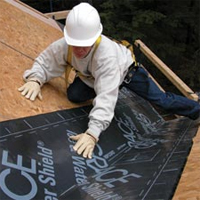Steel roofed post frame buildings are not required to have ice and water shields installed beneath them (International Building Code – Section 1507.4). However for most other types of roofing it is definitely a consideration, or even a requirement.
IBC Section 1507.2.8.2 requires ice dam protection in areas where the average daily temperature in January is 25 degrees F. or less or where there is a possibility of ice forming along the eaves causing a backup of water.
 Roofing Ice and Water shield is a critical component of many new roofing systems, especially in cold weather climates. Many local building codes require Ice and Water shield and, when required, the IBC states ice and water shield must start at the roofs eave edge and extend two feet inside the heated wall space of a structure.
Roofing Ice and Water shield is a critical component of many new roofing systems, especially in cold weather climates. Many local building codes require Ice and Water shield and, when required, the IBC states ice and water shield must start at the roofs eave edge and extend two feet inside the heated wall space of a structure.
Ice and Water shield is a peel and stick product which adheres directly to the oriented strand board (osb) or plywood roof deck. It forms a water-proof barrier where ice most often builds up on the eaves edge. It is also commonly applied in the valleys of a buildings as well as around any roof protrusions including; chimneys, pipe boots, roof vents and skylights. Essentially all the weakest or most prone to leaking areas of a roof should be coated with Ice and Water Shield before installing shingles or any non-steel panel roofing products.
Ice and water rolls come in different sizes, one or two square rolls (a square is supposed to be 100 square feet of coverage). However, many ice and water shield rolls are not exactly 100 or 200 square feet! Some rolls are smaller and some are larger than 100 or 200 square feet. Make sure to know the actual length of the selected rolls so jobsite shortages do not occur.
Thickness is another measure used when comparing ice and water shield. A lot of people believe thicker is better. When wanting to stop ice dams, thickness doesn’t mean very much. As long as the roll is at least 40 mils thick, it’s okay to use. One of the most important aspects of ice and water shield is how well it sticks to the roof deck. If it doesn’t stick well and lay flat, nothing has been done to protect against ice dams!
Ice and water shield surfaces come in three main forms; granular, sand and mat. Granular (sometimes referred to as mineral) surfaces are covered with granules which are about the same size as shingle granules. Granular surface rolls also tend to be a little heavier than rolls with a different type of surface. A sand surface has a fine layer of sand attached to the face of the ice and water shield. A mat surface, sometimes called film, poly or fabric, has no granules or sand attached to the surface. Surface selection on ice and water shield is important because some ice and water shields can become very slick when water is on their face.
A split release backer is a small slit down the middle of the ice and water shield roll which allows the ice and water shield backer to be taken off in two pieces. This is important because it allows for a quicker and easier installation. Almost all ice and water shields come with a split release backer.
Most ice and water shields come with some kind of limited warranty. Typically expect to find a five year limited warranty on most rolls.
Reinforcement in ice and water shield consists of tiny strands of fiberglass or polyester built into the base of the material. This may give the roll a little more rigidity and tear resistance.
Weight of ice and water shield is important. Like thickness, having more weight doesn’t make it a better product. When comparing weights less weight can actually be better. The lighter the roll, the easier it is the haul up a ladder and onto the roof. I would much rather carry a 32 pound 2 square roll of ice and water shield up a ladder than a 72 pound roll.
High temperature (HT) rolls are good to use when a roof deck is going to get over 150 degrees Fahrenheit. If installing under a metal roof using a high temp ice and water shield may be a good choice. Metal roofs will also require an ice and water shield with a non-abrasive surface so the bottom surface of the metal will not be abraded as it expands and contracts.
Ice and water shield the entire roof deck? While this is an extremely rare necessity it is sometimes called for. Some shingle manufacturers require Ice and water shield on very low sloped decks between 2/12 and 4/12. Also, if in a climate such as the Upper Peninsula of Michigan and routinely get over a foot of snow standing on the roof…it definitely is a consideration.






